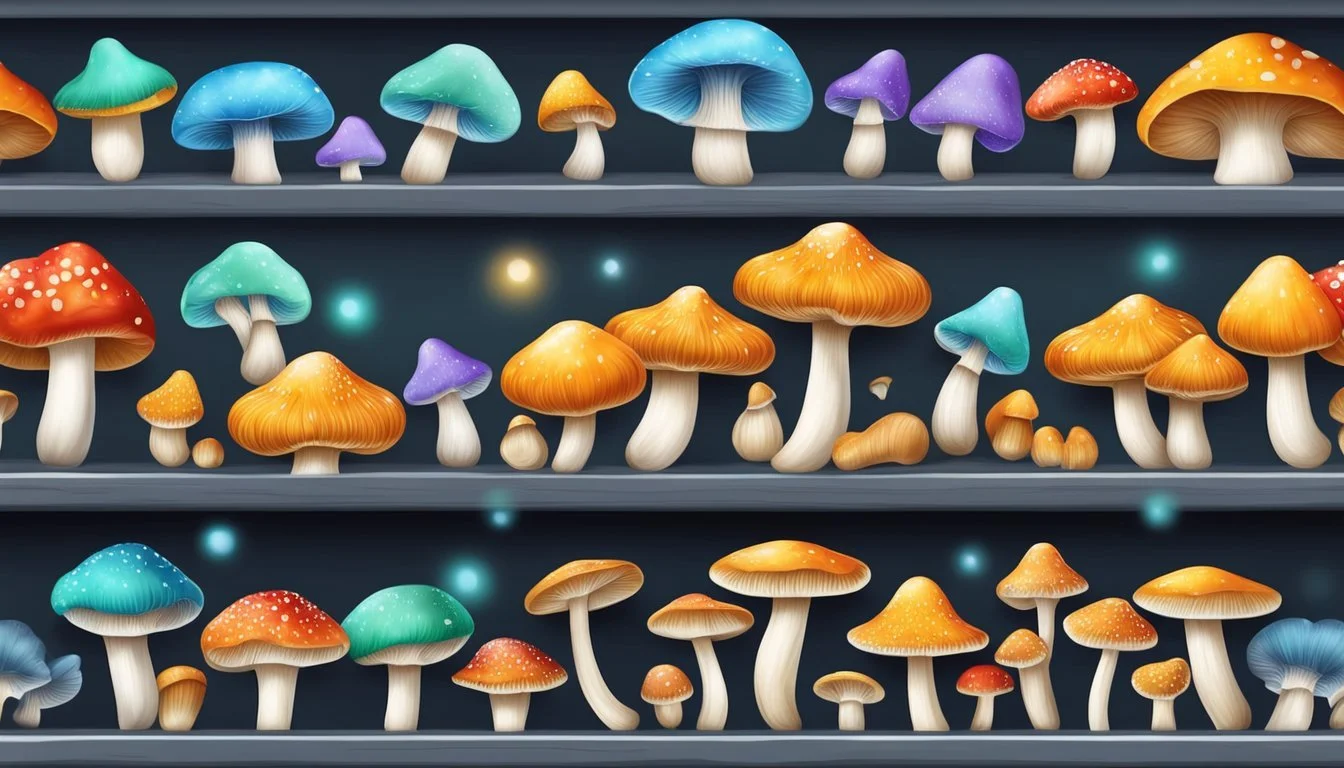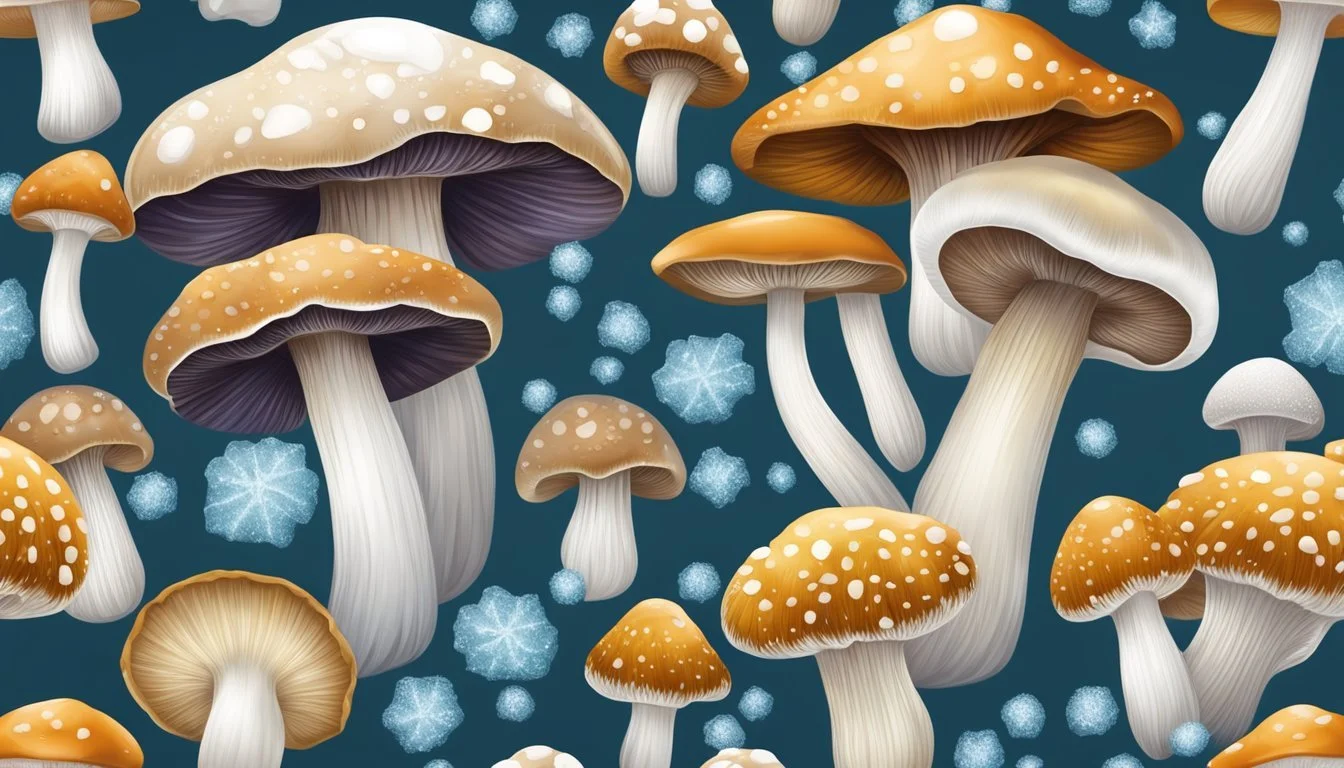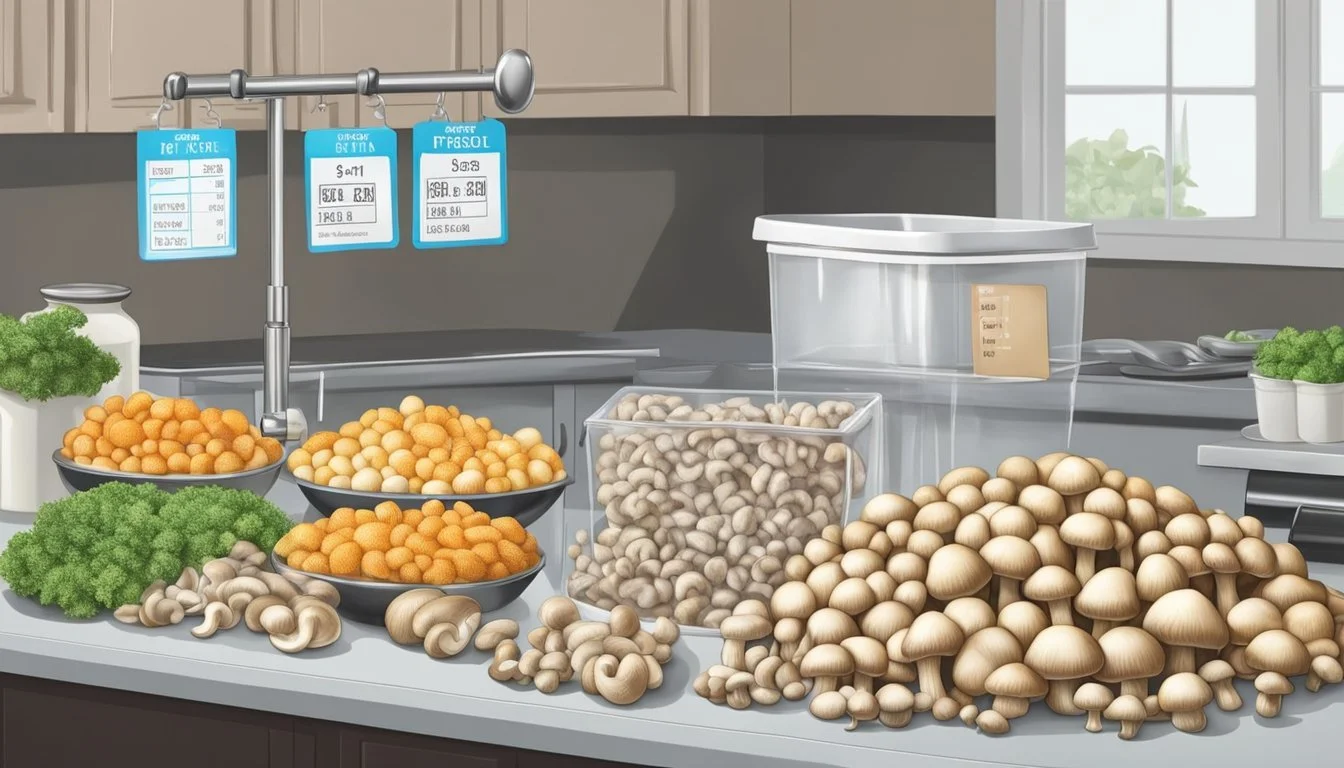Fresh vs Frozen Mushrooms: Comparing Flavor, Texture, and Culinary Uses
Mushrooms are a versatile and flavorful addition to many dishes, but the debate between fresh and frozen options often leaves home cooks puzzled. Both types have their merits and drawbacks, influencing texture, flavor, and convenience in cooking.
Fresh mushrooms generally offer superior texture and flavor compared to their frozen counterparts, but frozen mushrooms provide longer shelf life and convenience. Fresh mushrooms maintain their firm, meaty texture and delicate earthy taste, making them ideal for salads, stir-fries, and dishes where mushroom texture is crucial. Frozen mushrooms, while softer and slightly less flavorful, excel in cooked dishes like soups, stews, and sauces where texture changes are less noticeable.
The choice between fresh and frozen mushrooms often depends on intended use, storage capacity, and cooking time constraints. Fresh mushrooms typically last about a week in the refrigerator, while frozen ones can be stored for months. For quick meal preparations, frozen mushrooms can be added directly to hot pans without thawing, offering a time-saving option for busy cooks.
Understanding Mushrooms
Mushrooms are versatile fungi packed with nutrients and flavor. They come in various types, each with unique characteristics and culinary uses. Proper handling and preparation are key to maximizing their benefits and taste.
Nutritional Profile
Mushrooms are low in calories and fat while offering a range of essential nutrients. They contain B vitamins, including riboflavin, niacin, and pantothenic acid. These fungi are also a good source of minerals like selenium, copper, and potassium.
Many mushroom varieties provide antioxidants, including ergothioneine and glutathione. These compounds help protect cells from damage caused by free radicals.
Mushrooms are notably high in dietary fiber, supporting digestive health. Some types, like shiitake and maitake, contain beta-glucans, which may boost the immune system.
Varieties and Selection
Common edible mushroom varieties include white button, cremini, portobello, shiitake, and oyster. White button mushrooms are mild and versatile, while portobellos offer a meatier texture and robust flavor.
When selecting mushrooms, look for firm specimens with smooth caps. Avoid those with bruises, dark spots, or slimy surfaces. Fresh mushrooms should have a light, earthy scent.
Store-bought mushrooms are typically clean, but wild mushrooms require careful inspection. It's crucial to only consume mushrooms from trusted sources, as some wild varieties can be toxic.
Proper Cleaning Techniques
Clean mushrooms gently to preserve their delicate texture and flavor. Use a soft brush or paper towel to remove visible dirt from the surface. Avoid soaking mushrooms in water, as they absorb moisture quickly.
For stubborn dirt, dampen a paper towel and lightly wipe the mushroom. If necessary, rinse briefly under cool water and pat dry immediately. Trim off any discolored or damaged parts of the stem.
Mushrooms with exposed gills, like portobellos, may benefit from scraping out the gills with a spoon before cooking. This step can prevent dishes from becoming discolored during cooking.
Fresh Mushrooms: Benefits and Uses
Fresh mushrooms offer a unique texture and flavor that can enhance a wide variety of dishes. They provide versatility in the kitchen and nutritional benefits when prepared properly.
Savoring the Freshness
Fresh mushrooms have a distinct texture and taste that sets them apart from their frozen counterparts. They offer a firm, meaty bite and a more intense, earthy flavor. This makes them ideal for dishes where texture is crucial, such as salads or lightly cooked preparations.
Raw mushrooms can be sliced thinly for salads or sandwiches, providing a crisp element. When cooked, they release moisture and develop a tender consistency, absorbing flavors from other ingredients.
Culinary Applications
Fresh mushrooms are incredibly versatile in the kitchen. They can be sautéed, grilled, roasted, or used raw in various recipes. Sautéing mushrooms in butter or oil brings out their rich flavor and creates a golden-brown exterior.
They excel in pasta dishes, omelets, stir-fries, and as toppings for pizzas or burgers. Mushroom recipes often call for fresh varieties due to their superior texture and ability to caramelize when cooked.
Sauté with garlic and herbs for a simple side dish
Add to omelets for a protein-rich breakfast
Incorporate into pasta sauces for depth of flavor
Grill whole mushrooms as a vegetarian main course
Shelf Life and Storage
Fresh mushrooms have a relatively short shelf life compared to their frozen counterparts. To maximize freshness, store them in a paper bag or ventilated container in the refrigerator. This helps maintain their moisture content without causing sogginess.
Properly stored, fresh mushrooms can last 5-7 days. Avoid washing mushrooms until ready to use, as excess moisture can speed up spoilage. Instead, gently brush off any dirt.
For longer storage, consider drying or freezing mushrooms. However, these methods will alter their texture and are best used in cooked dishes rather than raw applications.
Frozen Mushrooms: Prepping and Cooking
Frozen mushrooms offer convenience and versatility in the kitchen. Proper freezing techniques and cooking methods can help preserve their flavor and texture for various dishes.
Freezing Techniques
To freeze mushrooms, start by cleaning and slicing them. Spread the slices on a baking sheet in a single layer. Place the sheet in the freezer for 1-2 hours until the mushrooms are firm.
Transfer the frozen mushrooms to freezer bags. Remove excess air from the bags to prevent freezer burn. Label the bags with the date and contents.
For cooked mushrooms, sauté them lightly before freezing. Allow them to cool completely. Pack the cooked mushrooms in airtight containers or freezer bags. They can be stored for up to 6 months.
Blanching is another option for freezing raw mushrooms. Boil them briefly, then plunge into ice water. Drain and pat dry before freezing.
Thawing and Cooking Methods
Thaw frozen mushrooms in the refrigerator overnight or use them directly in cooking. For quick thawing, place them in a colander and run cool water over them.
Add thawed mushrooms to soups, stews, and casseroles. Their moisture content works well in these dishes. For stir-fries or sautés, cook frozen mushrooms directly in a hot skillet.
Roasting enhances the flavor of thawed mushrooms. Spread them on a baking sheet, toss with oil and seasonings, and roast at 400°F for 20-25 minutes. Frozen mushrooms can also be steamed or added to pasta sauces.
For stroganoff or similar dishes, use thawed mushrooms as you would fresh ones. They may release more liquid, so adjust cooking times accordingly.
Texture and Flavor Considerations
Frozen and fresh mushrooms differ in their texture and flavor profiles. These differences impact their culinary uses and overall eating experience.
Impact on Texture
Freezing mushrooms alters their cellular structure, resulting in a softer texture compared to fresh ones. When thawed, frozen mushrooms release more moisture due to ice crystal formation during the freezing process. This texture change makes them ideal for cooked dishes like soups, stews, and sauces.
Fresh mushrooms maintain a firm, springy texture that's desirable in raw applications such as salads. They also hold up better when sautéed or grilled, providing a satisfying bite.
For dishes where texture is crucial, fresh mushrooms are often preferred. However, frozen mushrooms can be a convenient option for recipes where a softer texture is acceptable or even desirable.
Flavor Profiles and Enhancements
The freezing process doesn't significantly impact the umami flavor of mushrooms. Both fresh and frozen varieties retain their earthy, savory taste. However, frozen mushrooms may have a slightly less intense flavor due to moisture loss during thawing.
Fresh mushrooms offer a bright, clean taste that's particularly noticeable when eaten raw or lightly cooked. Their flavor can be enhanced through various cooking methods like roasting or grilling.
Frozen mushrooms work well in dishes with strong flavors or long cooking times. They readily absorb seasonings and aromatics, making them excellent for soups, stews, and casseroles. To maximize flavor, consider sautéing thawed mushrooms before adding them to recipes.
Versatility in Recipes
Mushrooms, whether fresh or frozen, offer incredible versatility in cooking. They adapt well to various dishes and preparation methods, enhancing flavors and textures across a wide range of cuisines.
Soups and Stews
Mushrooms excel in soups and stews, adding depth and earthiness. Frozen mushrooms work particularly well in these liquid-based dishes. Their softer texture after thawing blends seamlessly into broths and creamy bases.
Mushroom soup is a classic that showcases the fungi's rich flavor. Both fresh and frozen varieties can be used to create a velvety, comforting dish. In hearty stews, mushrooms absorb surrounding flavors while contributing their own unique taste.
For a quick weeknight meal, frozen mushrooms can be added directly to simmering soups without thawing. This convenience makes them a pantry staple for impromptu cooking.
Main Courses and Sides
Mushrooms feature prominently in many main dishes and side plates. Fresh mushrooms are often preferred for stir-fries and sautés due to their firmer texture and ability to caramelize.
Frozen mushrooms shine in pasta sauces and gravies. Their released moisture during cooking helps create silky, flavorful sauces. They also work well in casseroles and baked dishes where texture changes are less noticeable.
For side dishes, both fresh and frozen mushrooms can be roasted, grilled, or incorporated into rice or grain-based recipes. Frozen mushrooms are particularly useful for quick vegetable medleys or as pizza toppings.
Innovative Mushroom Dishes
Creative cooks are finding new ways to incorporate mushrooms into innovative recipes. Frozen mushrooms can be blended into veggie burgers or used as meat substitutes in tacos and sandwiches.
Fresh mushrooms are ideal for stuffing or as vessels for other ingredients. They can be hollowed out and filled with cheese, herbs, or other vegetables before baking.
Mushroom powders made from dehydrated fungi add umami to various dishes. This versatile ingredient can be sprinkled on popcorn, mixed into seasonings, or used to boost flavor in plant-based recipes.
Fermented mushrooms are gaining popularity, offering a unique tangy flavor profile. Both fresh and frozen mushrooms can be used in fermentation processes, creating exciting new condiments and preserves.
Maximizing Shelf Life and Quality
Proper storage techniques are crucial for maintaining mushroom freshness and quality. Refrigeration and freezing methods can significantly extend shelf life while preserving flavor and texture.
Refrigeration Best Practices
Store fresh mushrooms in paper bags or breathable containers to prevent moisture buildup. Place them in the main refrigerator compartment, not the crisper drawer, at 32-36°F (0-2°C). Avoid washing mushrooms before storage, as excess moisture promotes bacterial growth.
Check mushrooms daily for signs of spoilage. Remove any slimy or discolored specimens to prevent contamination. Whole mushrooms typically last 7-10 days when refrigerated properly. Sliced mushrooms have a shorter shelf life of 5-7 days.
For optimal quality, consume refrigerated mushrooms within the first few days of storage. As time passes, their flavor and nutritional value may gradually diminish.
Freezing and Defrosting Tips
Freezing extends mushroom shelf life to 9-12 months. Clean and slice mushrooms before freezing. Blanch them in boiling water for 2-3 minutes to preserve color and texture, then plunge into ice water to stop cooking.
Pat mushrooms dry and arrange them in a single layer on a baking sheet. Freeze until solid, then transfer to airtight freezer bags. Remove excess air to prevent freezer burn.
Label bags with the date to track storage time. For best quality, use frozen mushrooms within 6 months. Thaw frozen mushrooms in the refrigerator overnight or add them directly to cooked dishes.
Frozen mushrooms work well in soups, stews, and sauces. Their texture may be slightly softer than fresh, making them less suitable for raw applications.
Health and Nutrition Aspects
Mushrooms offer a wealth of nutritional benefits, packing essential nutrients into a low-calorie package. They provide important vitamins, minerals, and antioxidants that support overall health.
Mushrooms as a Nutrient-Dense Food
Mushrooms are an excellent source of several key nutrients. One cup of raw mushrooms contains only 15 calories while providing 2.2 grams of protein and 2.3 grams of carbohydrates.
Mushrooms are rich in B vitamins, including riboflavin, niacin, and pantothenic acid. These vitamins play crucial roles in energy production and nervous system function.
Minerals abound in mushrooms. They contain copper, which supports bone health and immune function. Potassium, important for heart health and muscle function, is also present in significant amounts.
Mushrooms are one of the few non-animal sources of vitamin D. When exposed to UV light, they can produce this essential nutrient that aids in calcium absorption and bone health.
Antioxidants in mushrooms, such as ergothioneine and glutathione, help protect cells from damage. These compounds may have anti-inflammatory effects and support overall immune function.
Economic and Practical Considerations
Fresh and frozen mushrooms each offer distinct advantages when it comes to cost-effectiveness and convenience. The choice between them can significantly impact meal planning and budgeting.
Budget-Friendly Choices
Frozen mushrooms often prove more cost-effective for budget-conscious consumers. They have a longer shelf life, reducing food waste and allowing for bulk purchases during sales. Fresh mushrooms, while typically pricier, can be economical when bought in season or from local sources.
Pricing fluctuates based on variety and availability. Common button mushrooms tend to be cheaper fresh, while specialty types like shiitake or oyster mushrooms may offer better value frozen.
Many grocery stores offer store-brand frozen mushrooms at competitive prices. These can be a smart choice for frequent mushroom users looking to save money without sacrificing quality.
Meal Planning with Mushrooms
Frozen mushrooms excel in meal prep scenarios. They come pre-cleaned and sliced, saving time and effort. Cooks can easily portion out exact amounts needed, reducing waste.
Fresh mushrooms require more immediate use but offer versatility in texture and appearance. They're ideal for dishes where mushrooms are a focal point, like salads or stir-fries.
Freezer storage allows for long-term meal planning. Frozen mushrooms can be kept for months, ensuring a ready supply for recipes. However, it's important to note that refreezing mushrooms isn't recommended, as it can negatively affect texture and flavor.
For last-minute cooking, fresh mushrooms are more convenient. They don't require thawing and can be quickly incorporated into meals.







